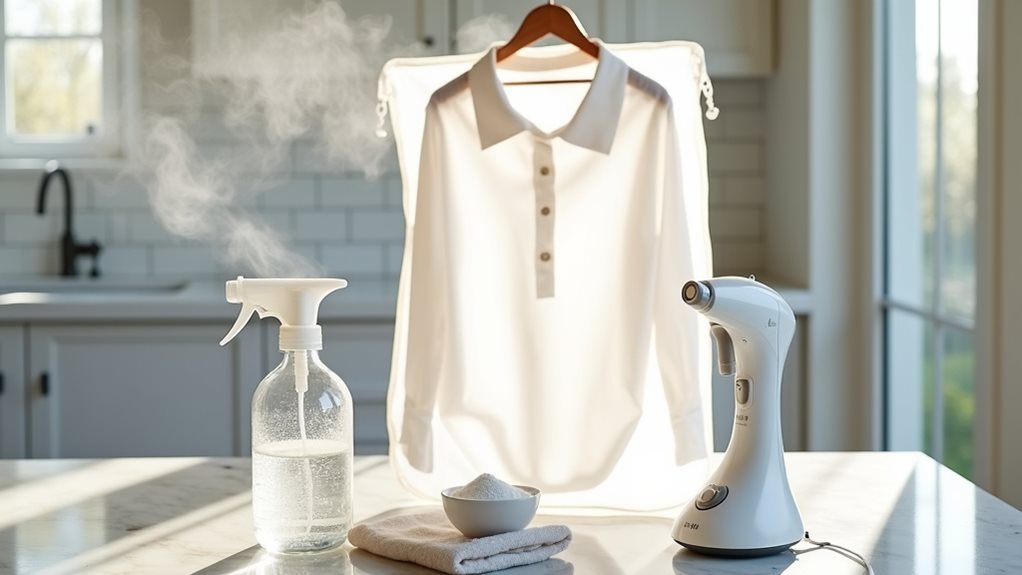You can dry clean at home using simple household items like distilled white vinegar, baking soda, and microfiber cloths – I’ve saved hundreds doing this myself! Start by checking care labels, then treat stains with equal parts vinegar and water, working from outside edges inward. Use home dry cleaning kits for delicate fabrics, steam to remove wrinkles, and always air dry in well-ventilated spaces. The complete process reveals professional-quality results.
Essential Materials and Supplies Needed

Before you plunge into transforming your laundry routine, you’ll need to gather a surprisingly simple arsenal of household supplies that probably already live in your kitchen cabinets and cleaning closet.
Your crucial materials include distilled white vinegar, baking soda, and a clean microfiber cloth—seriously, these three work magic together!
Don’t forget a garment bag to protect your delicate fabrics during the cleaning process, because trust me, I’ve learned that lesson the hard way 😅.
You’ll also want mild detergent for spot cleaning, a steam cleaner (or just your dryer with a damp cloth), and a soft-bristle brush for maintenance.
Most importantly, choose a well-ventilated area for safety and freshness.
These home cleaning alternatives work particularly well for everyday items like blouses and dresses, while structured items such as suits with interfacing will still require professional dry cleaning services.
Preparing Your Garments for Home Dry Cleaning
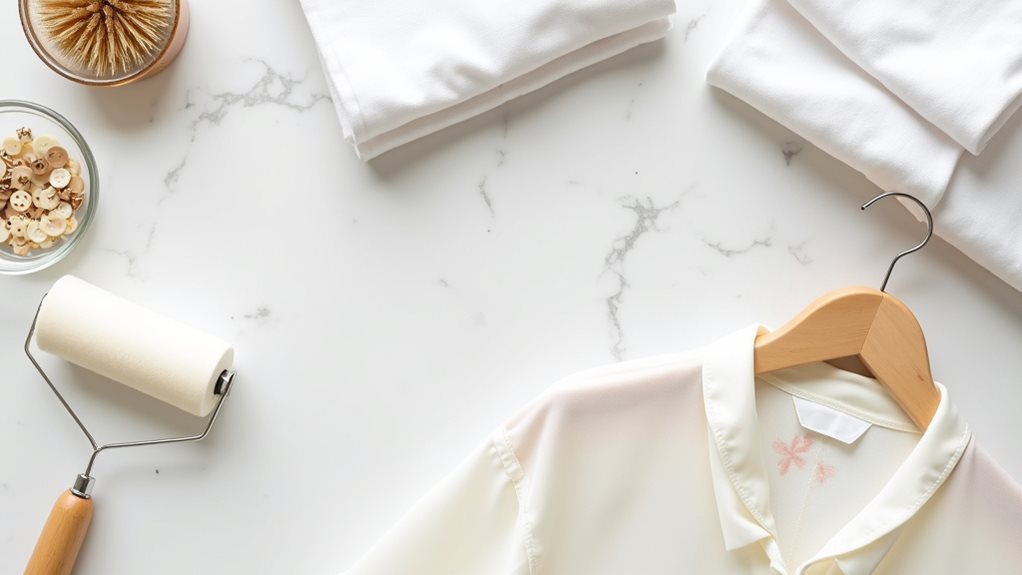
Three vital steps will make or break your home dry cleaning adventure, and honestly, I wish someone had explained this to me before I accidentally turned my favorite silk blouse into what looked like a tie-dye experiment gone wrong.
Learn from my costly mistake—that silk blouse disaster could have been avoided with proper preparation and technique.
When you’re ready to dry clean your clothes at home, proper preparation isn’t just helpful—it’s absolutely imperative for garment protection and your safety.
Before touching any cleaning solvents, you’ll want to work in a well-ventilated area to avoid inhaling harmful fumes that could make you dizzy or worse.
- Check the care label thoroughly to confirm your garment is suitable for home dry cleaning
- Remove all accessories like belts, pins, or jewelry to prevent damage
- Perform a spot test on a hidden area to check for colorfastness
- Sprinkle baking soda for effective odor absorption before cleaning
- Guarantee proper ventilation throughout your workspace
Consider purchasing home dry cleaning kits from your local store as a safer alternative to professional chemical solvents like perchloroethylene.
Step-by-Step Home Dry Cleaning Process

Now that you’ve sorted through your clothes like I do before a big trip (checking every pocket twice because I once washed a tube of lipstick 😅), it’s time to tackle the actual cleaning process with confidence and care.
You’ll want to gather your supplies first, treat any stubborn spots with the gentle attention they deserve, then move through the washing and drying steps that’ll leave your garments looking professionally refreshed.
Think of this as your personal spa day for clothes, where each step builds on the last to create that crisp, clean finish you’re after.
Modern home dry cleaning kits provide everything you need to safely clean silk, wool, and other delicate fabrics using your regular washing machine.
Gather Essential Cleaning Supplies
Success in home dry cleaning hinges on having the right arsenal of supplies at your fingertips, much like how my grandmother always kept her sewing kit perfectly organized because she knew that preparation meant the difference between a quick fix and a complete disaster.
When you gather crucial supplies beforehand, you’ll save yourself from those frustrating mid-project runs to the store that always seem to happen at the worst possible moments.
Here’s what you’ll need for effective home dry cleaning:
- White vinegar and water for creating your go-to cleaning solution
- Baking soda for deodorizing and freshening delicate fabrics
- Clean microfiber cloth for gentle spot cleaning without damaging fibers
- Garment bag to protect your clothes during the cleaning process
- Well-ventilated area to guarantee safe handling of cleaning solvents
Alternatively, you can purchase home dry cleaning kits that contain pre-moistened stain removal pens and specialized cleaning cloths designed to work with your dryer’s heat to release cleaning vapors.
Pre-Treatment and Preparation Steps
Before you dive headfirst into the actual cleaning process, taking time for proper pre-treatment will save you from the heartbreak I experienced when I ruined my favorite silk blouse by skipping these crucial first steps.
Start by checking your garment’s care label—trust me, it’s worth those extra thirty seconds!
Next, find a well-ventilated space to air out your delicate items while sprinkling baking soda over any odorous areas.
After fifteen minutes, conduct a spot test using equal parts white vinegar and water on a hidden seam to check colorfastness.
For visible stains, gently blot with your cleaning solution using a microfiber cloth.
Consider using at-home dry cleaning kits with special cloths and stain removers as an alternative to traditional chemical solvents.
Finally, refresh everything with steam before guaranteeing complete drying—patience prevents mildew disasters!
Cleaning and Drying Methods
Once you’ve completed the pre-treatment steps, the actual cleaning process becomes surprisingly straightforward, though I’ll admit I was skeptical when my grandmother first taught me these techniques in her cramped laundry room twenty years ago.
Now I understand why she swore by dry cleaning at home instead of expensive professional services.
The key to success lies in matching your approach to the fabric type and treating each garment with patience:
- Hand wash delicate items in cool water with mild detergent, soaking for 20 minutes
- Remove stains using spot-cleaning techniques before full cleaning
- Apply baking soda generously to absorb stubborn odors and moisture
- Use gentle steam from your shower or steamer to eliminate wrinkles
- Air dry completely in well-ventilated spaces to clean clothes at home effectively
Before attempting any cleaning method, always test your chosen technique on an inconspicuous area of the garment to ensure the fabric care labels and material can handle the treatment safely.
Effective Stain Removal Techniques
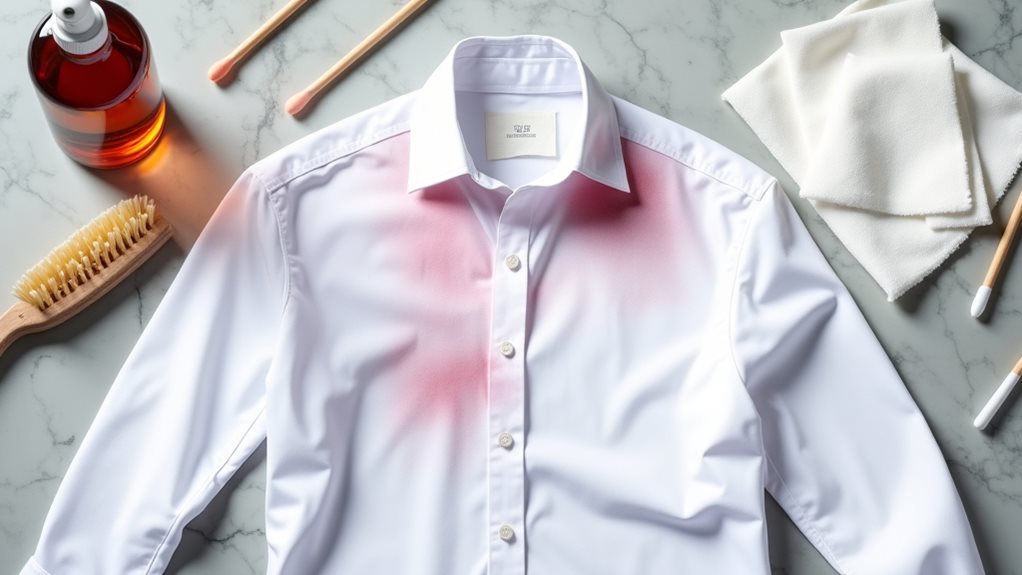
When stains strike your favorite garments, you don’t need to panic or immediately surrender to expensive dry cleaning bills, because mastering a few simple techniques can transform you into your own stain-fighting hero.
For effective stain removal, start with a solution of equal parts white vinegar and water, then dampen your cloth and blot the stain from outside edges inward—trust me, this prevents spreading disasters I’ve learned the hard way! 😅
Use a soft-bristle brush for gentle scrubbing on delicate fibers, always testing solutions first on hidden areas.
For stubborn marks, oxygen bleach works wonders during washing, though you’ll want to rinse thoroughly afterward to prevent residue buildup.
Keep in mind that while home methods work well for many stains, oil-based stains like grease and makeup may require professional dry cleaning with specialized chemical solvents for complete removal.
Proper Drying and Finishing Methods

After you’ve conquered those stubborn stains, the real magic happens during the drying and finishing process, where one wrong move can turn your victory into a wrinkled disaster that’ll have you questioning your life choices! 😬
I learned this lesson the hard way when I tossed my favorite silk blouse into the dryer on high heat—let’s just say it came out looking like it belonged in a dollhouse rather than my closet.
Here’s your foolproof roadmap for proper drying success:
- Always check the care label first, then conduct a spot test before committing to any drying method
- Air drying flat on towels works best for most garments, preventing unwanted stretching and shape distortion
- Hang delicate fabrics like silk on plastic hangers in well-ventilated spaces to avoid creasing
- Use a garment bag with low-temperature setting if you must machine dry certain fabrics
- Finish with gentle steaming from a distance to eliminate wrinkles and refresh your beautifully cleaned pieces
Remember that your freshly cleaned garments can get wet from light rain or spills without damage, but immediate drying is recommended to prevent water spots or color bleeding.
Clothes Suitable for Home Dry Cleaning
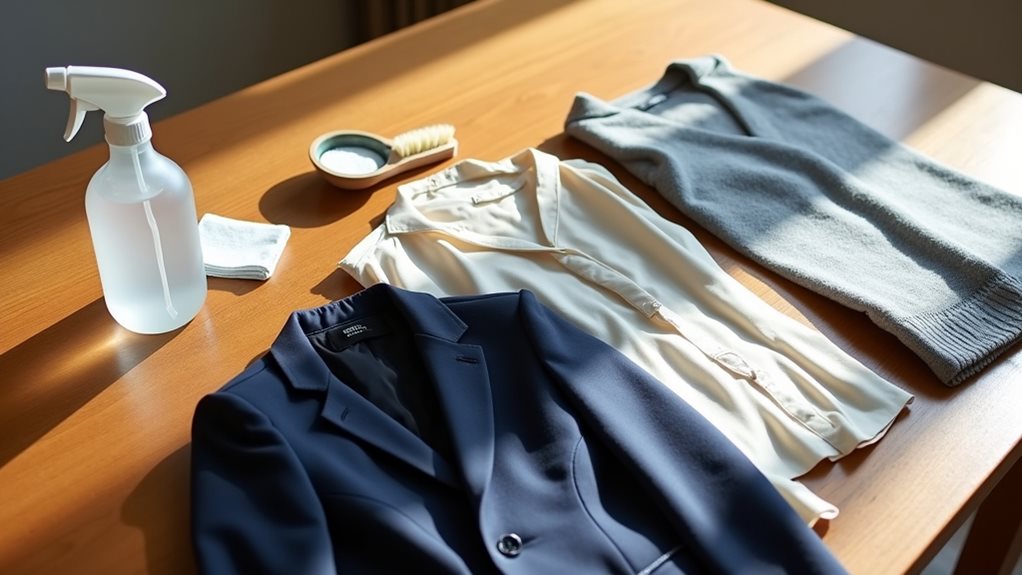
You’ll find that certain fabrics practically beg for the gentle touch of home dry cleaning, especially those luxurious silks and cashmeres that seem to whisper “handle with care” every time you pull them from your closet.
Understanding which garments can safely undergo your DIY treatment versus those that need professional attention will save you from the heartbreak I experienced when I accidentally turned my favorite wool sweater into doll clothes 😅.
Home dry cleaning kits work most effectively on lightly soiled items and can help refresh your clothes while removing minor odors and reducing wrinkles.
Before you start experimenting with your wardrobe, though, it’s essential to recognize the warning signs of items that should never meet your home dry cleaning kit, no matter how confident you’re feeling about your newfound skills.
Delicate Fabric Types
Since discovering that my favorite silk blouse didn’t actually need a trip to the expensive dry cleaner down the street, I’ve become somewhat of a detective when it comes to identifying which delicate fabrics can safely undergo home dry cleaning treatments.
You’ll find that certain materials practically beg for gentle home care rather than harsh commercial processes. The key lies in understanding your fabric’s personality – silk whispers elegance but demands respect, while wool can be surprisingly forgiving when treated properly.
Here are the delicate fabrics that typically respond well to home dry cleaning:
- Silk – requires gentle handling and temperature control
- Cashmere – benefits from careful spot cleaning techniques
- Wool – surprisingly resilient with proper methods
- Rayon – check the care label first for specific requirements
- Certain blends – always perform a spot test beforehand
These delicate materials require specialized cleaning methods because water-based washing can cause significant damage, shrinkage, or color bleeding that permanently ruins the garment’s appearance and texture.
Basic Garment Categories
Understanding which garments actually benefit from home dry cleaning, rather than heading straight to the professionals, has saved me both money and countless trips across town while teaching me that most clothing categories fall into surprisingly manageable groups.
You’ll find that basic cotton pieces, unstructured jackets, and everyday blouses respond beautifully to gentle cleaning methods at home, especially when you’re dealing with light stains or freshening needs.
While delicate fabrics like silk require extra caution, they’re still candidates for dry cleaning at home if you’re willing to do a spot test first.
Save professional cleaning for heavily soiled items or structured pieces—your wallet will thank you, and you’ll discover that dry clean clothes aren’t as intimidating as they seem! 😊
Items to Avoid
Although I’ve learned through some rather expensive mistakes which clothes work wonderfully for home dry cleaning, I’ve also discovered the hard way that certain garments should absolutely stay off your DIY list, no matter how confident you’re feeling about your newfound skills.
Delicate fabrics like silk and cashmere need professional care, trust me on this one 😅.
Structured garments, especially suits with those perfectly fitted shoulders, can lose their shape faster than you can say “oops.”
Leather and suede items will absolutely hate you forever if you attempt home treatment, and antique clothing deserves the respect of expert hands.
- Silk, cashmere, and other delicate fabrics requiring gentle handling
- Structured suits, blazers, and formal wear with intricate construction
- Leather jackets, suede coats, and similar materials
- Valuable garments and antique clothing pieces
- Fabrics prone to shrinking or color bleeding like rayon
Items That Require Professional Cleaning Services
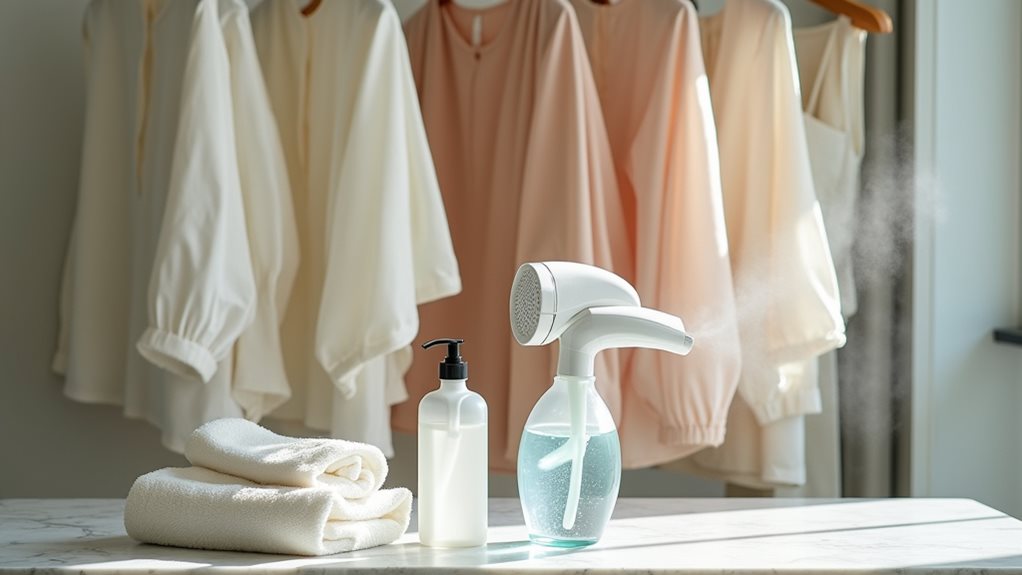
While home dry cleaning can handle many garments beautifully, certain precious items deserve the white-glove treatment that only professional services can provide. Trust me, I’ve learned this lesson the hard way after ruining my grandmother’s vintage silk blouse with an overzealous DIY attempt 😅.
Your wedding dress, with its intricate designs and delicate fabrics, needs a professional dry cleaner who understands preservation techniques. Structured suits with shoulder padding require specialized care to maintain their shape, while valuable clothing and antique pieces demand expertise you simply can’t replicate at home.
When you see “dry clean only” labels, heed that warning—I’ve witnessed too much shrinkage from well-intentioned home attempts that ended in heartbreak and expensive replacement costs.

